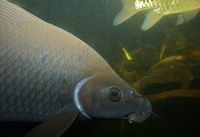Difference between revisions of "Labeo chrysophekadion"
From The Aquarium Wiki
(→Diet: I've been feeding my Black Shark almost exclusively with Algae Discs for 16 years. Added "algae discs" to list of foods.) (Tag: Visual edit) |
m (Change to Feeding Regime and Life Span Maximum. I have kept a Labeo chrysophekadion for 20 years and it's still going and growing) |
||
| Line 23: | Line 23: | ||
|food_other=Yes | |food_other=Yes | ||
|min_life_span=5 | |min_life_span=5 | ||
| − | |max_life_span= | + | |max_life_span=20+ |
|min_sg=1 | |min_sg=1 | ||
|max_sg=1 | |max_sg=1 | ||
| Line 54: | Line 54: | ||
== Feeding regime == | == Feeding regime == | ||
| − | :Feed once or twice a day. | + | :Feed frequently. This species will eat all day long but can survive with once or twice a day feeding. |
| Line 62: | Line 62: | ||
== Behaviour == | == Behaviour == | ||
| − | :A fish that is highly territorial towards conspecifics and not suitable in a community aquarium. | + | :A fish that is highly territorial towards conspecifics and not suitable in a community aquarium. Level of activity is dependent on nutrition. More food, more action. Lessfood less action. |
Latest revision as of 00:08, 12 January 2021
Black Shark
Labeo chrysophekadion
400 Litres (105.7)
30-60 cm (11.8-23.6")
Freshwater
6.5 - 7.5
23.9-27.2°C (75 -81 °F)
10-15 °d
1:1 M:F
5-20+ years
Family
Cyprinidae
Contents
Additional names
- Black Sharkminnow, Black Labeo
Additional scientific names
- Morulius chrysophekadion, Rohita chrysophekadion, Labeo negro
Origin[edit]
- This fish originates from Asia, found across the Mekong and Chao Phraya basins, Malay Peninsula, Sumatra, Java and Borneo.
Sexing[edit]
- Difficult to visually determine the sex. There are no records of this fish being bred in captivity.
Tank compatibility[edit]
- This fish should not be kept in a community tank, with fish smaller than itself or anything delicate. It is aggressive, and territorial and best kept in a lone species tank as they will not tolerate their own kind or other shark-like fish. Can possible be kept with other robust similar sized fish but introduction should be done carefully, and as this fish mainly occupies the lower levels of the tank, other fish in this region may be bullied.
Diet[edit]
- Will accept most foods including pellets, algae discs, and flakes as well as live/frozen foods such as bloodworms and tubifex. Not safe for planted tanks.
Feeding regime[edit]
- Feed frequently. This species will eat all day long but can survive with once or twice a day feeding.
Environment specifics[edit]
- Needs a very large and spacious tank with some hiding places and room to roam without getting damaged, a secure lid is a must and sharp or unstable décor should be avoided.
Behaviour[edit]
- A fish that is highly territorial towards conspecifics and not suitable in a community aquarium. Level of activity is dependent on nutrition. More food, more action. Lessfood less action.
Identification[edit]
- Similar to the Bala Shark in shape but with a larger dorsal fin, this fish is deep brown-black in colouration throughout the whole body and the fins.
Pictures[edit]
Black Shark with German Blue Ram (not an advisable combination)
Videos[edit]
| In a community tank: |
External links[edit]
- Fishbase (Mirrors:
 )
)
- Aquaria Central
- Tropical Fish Gallery - pictures


